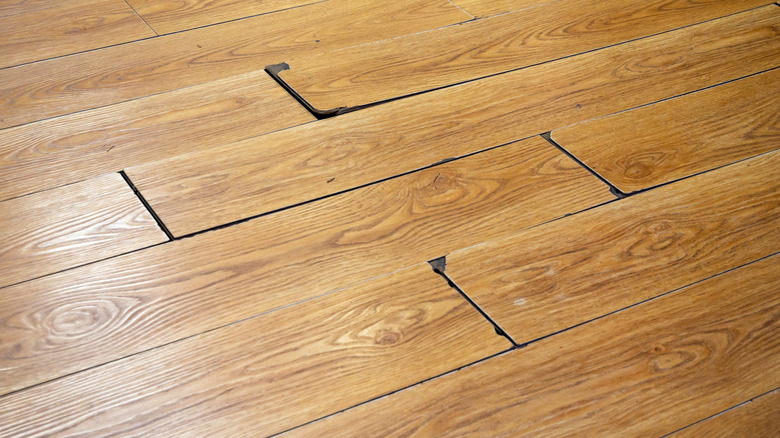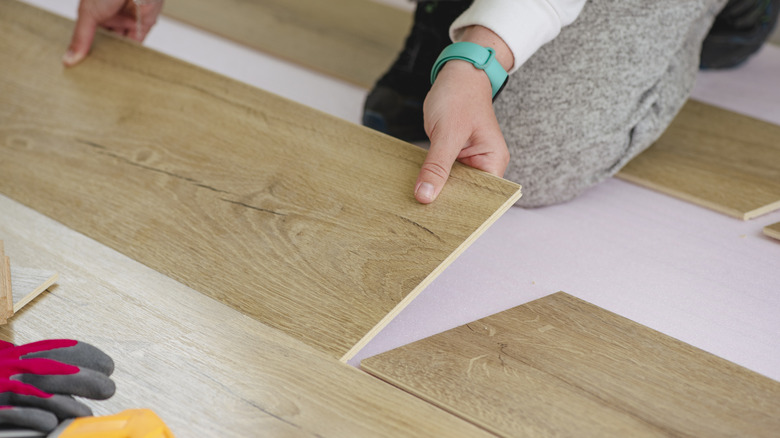The Quick Fix To Repair Gaps In Laminate Flooring Without Breaking The Bank
We may receive a commission on purchases made from links.
Most laminate flooring comes with a click-lock system (also known as floating floors) which makes it easy to install. Each board has an interlocking tongue and groove mechanism that clicks the board into place. If the mechanism breaks, though, the floorboard will slide, causing a gap.
Such gaps between your laminate floorboards looks unsightly and cheap. And it is inevitably the spot where you lose your credit card or spare change, never to be seen again. However, these gaps in laminate flooring are risky to more than just your dropped items: Separating planks can slide, causing a stumbling block. If you see a gap forming between laminate planks, you need to remedy the problem as soon as possible. Thankfully, there's an easy, cost-effective, and immediate solution to the problem of gaps in laminate flooring — and it's duct tape. But not in the way you might think.
In an exclusive interview with Josh Byrd, owner of Footprints Floors Nashville, he explained to Hunker that the dangers of these gaps are real. "[They are] a potential safety hazard for tenants." And when it comes to applying the hack, he advised that the goal of using duct tape is not to hold the planks together, but rather to grip the plank, allowing you to kick it firmly back in place. Let's take a look at how it's done, and also investigate long-term solutions.
Duct tape on laminate floors is a temporary solution to a permanent problem
Applying the duct tape hack to laminate floors is absolutely a worthwhile way to buy yourself some time before doing serious repairs, and it's one that Footprints Floors Nashville owner Josh Byrd has seen before. "Think of these floors as a more difficult-to-maneuver version of a slider puzzle," says Byrd. If you don't have duct tape on hand, Byrd recommends wearing shoes with good grip and kicking the plank into place. "[Do it] like a bull pawing the ground before he charges."
In practice, this means making a foot-long line of duct tape on the plank without separating it from the roll. Place your foot on the duct tape, then pull the roll up vertically to your chest. Kick the plank into place, then remove the duct tape. Sliding planks back into place can take some effort, and the duct tape is strong enough to give you the grip you need.
However, once this is done, don't assume the problem is permanently solved. A bit of movement in wood-based flooring is to be expected due to changes in temperature and humidity, and the weather can be the reason your floors are squeaking, but it shouldn't cause noticeable gaps between floorboards. Noticeable gaps are a sign of a bigger problem, such as improper installation, an uneven subfloor, or a failed locking mechanism. As Byrd told Hunker in our exclusive interview, "This can help slide planks back together if they are separating at the end joints ... however, if planks are separating, this will only be a temporary fix."
There are more permanent solutions to the floor-gap problem
If you've used the duct tape hack to get your boards back into place, but the problem persists, it's time to move to a more permanent solution. "The proper fix is to remove any damaged planks and replace them with new," says Josh Byrd, owner of Footprints Floors Nashville.
Yes, if the locking mechanism is broken on your plank, replacing it with matching laminate flooring may be the only permanent fix. Of course, it could be that the boards didn't click together properly during installation, in which case you can simply click them back together (check this option first before throwing out your board). But that's less likely. If budget is an issue — or if you have only one pesky plank — calling in the professionals could seem like overkill.
In such cases, there is a DIY that Byrd recommends over just doing the duct tape: "Apply some wood glue to the click-lock joints prior to sliding the planks back together, essentially reconnecting the planks when the locking mechanism no longer can." Wood glue such as Titebond is a superglue specially formulated for anything wood (or wood-adjacent), and works well to hold planks into place. Use a cotton swab or toothpick to apply the glue to the end of the floorboard, and kick the plank into place before it dries, using the duct-tape method or shoes with really good grip. Finally, clean up any excess glue with a damp cloth or putty knife.

